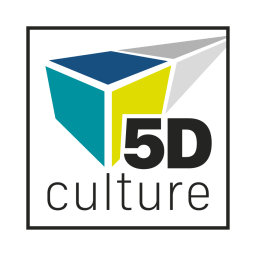After two years of international cooperation, the 5Dculture project has achieved a remarkable transformation in how European cultural heritage is preserved, shared, and reimagined through the power of 3D technologies. Looking back, the project has delivered tangible results that showcase the potential of 3D assets to inspire innovation and foster reuse across key sectors, including education, tourism, conservation, and the creative industries. By enriching the Common European Data Space for Cultural Heritage and providing tools, resources, and real-world scenarios, 5Dculture has created a foundation for a more accessible, engaging, and sustainable digital heritage ecosystem.
Delivering High-Quality 3D Content
One of the major achievements of
5Dculture has been the delivery of high-quality 3D assets focusing on Europe’s vast cultural heritage in fashion, archaeology, and architecture. The project identified existing datasets within partner collections, enhanced their quality through advanced processing workflows, and aggregated them into the Data Space. A total of
hundreds of 3D models were improved, enriched, and made available for public reuse, reaching new audiences and opening avenues for cross-sector collaboration.
Follow the links to discover the collections of news 3D models added and updated 3D models on Europeana:
New models -
Updated models.
Showcasing Impact through Real-World Reuse Scenarios
The project developed eight reuse scenarios that brought 3D content to life in diverse and impactful ways:
- Fashion Collections: Through immersive virtual tools, 5Dculture redefined the way fashion heritage is experienced in museums. By exploring 3D renderings of garments, fabrics, and accessories, the project created engaging exhibitions that allowed audiences to interact with fashion’s intricate craftsmanship either as a solo experience through augmented reality or together with a friend through social virtual reality. These innovations bridged history and technology, enhancing storytelling and visitor engagement.
- Archaeology: The reuse of archaeological 3D content became a standout achievement. At the Brú na Bóinne World Heritage Site, legacy 3D models were revitalized with advanced texturing and metadata enrichment, bringing new life to monuments, artifacts, and megalithic art. The project delivered unique solutions for accessible tourism, conservation and creative industries. In Spain, a collection of 3D models of archaeological objects related to the culture of the Iberians was extensively used in education, with different workshops being carried at primary, secondary and university levels. A specific focus was also put towards the use of 3D prints and audio description by blind people. Finally an inclusive experience was launched at the Ibero Museum of Jaén.
- Historic Buildings and Cityscapes: The project explored innovative tools to enhance virtual cultural tourism, education, and research for Europe’s architectural heritage. Through interactive 3D models and visualizations, users experienced historic buildings and cityscapes with unprecedented realism and detail, contributing to the understanding and promotion of cultural landmarks. One of the highlights has been the low-cost holographic postcards that fascinated the tourists of Idrija.
Empowering Cultural Heritage Institutions
To ensure the long-term impact of its work, 5Dculture focused on equipping cultural heritage institutions with the skills, tools, and resources to manage and reuse 3D content effectively. The project:
- Deployed AI and semantic technologies to streamline the processing, categorization, and linking of 3D assets, making them shareable, searchable, and accessible.
- Created capacity-building materials and workshops that empowered institutions with practical knowledge to adopt 3D technologies and integrate them into their workflows. These initiatives fostered confidence and readiness among cultural heritage professionals to unlock the full potential of their digital assets.
Connecting Stakeholders and Building a Community of Practice
The success of 5Dculture extended beyond its technical outputs by fostering collaboration among cultural heritage organizations, educators, creative professionals, policymakers, and researchers. The project established a Community of Practice that serves as a hub for knowledge-sharing, innovation, and support. Through outreach, events, and capacity-building activities, 5Dculture created strong connections across sectors, amplifying the reuse of 3D assets and encouraging cross-disciplinary engagement.
The 5Dculture project coordinator Alexandru Stan reflects: “We are really proud of the many results we were able to achieve: from AI, 3D and visualisation tools to the many capacity building activities and training resources created. And of course the highlight has been the 3D reuse scenarios which are not only inspiring but provide a template for other stakeholders to follow and expand. One of the key aspects that determined this success was the fact that the team was not only very motivated but its expertise was interdisciplinary: AI, 3D, software development, Europeana aggregation, and cultural heritage. Also, being able to cover several cultural heritage domains in the same project was beneficial because it enabled an exchange of best practices, lessons learned and know-how that would otherwise have been limited. Our IN2 team is looking forward to continuing the collaboration and supporting the Data Space for Cultural Heritage in its goals towards providing access to more 3D assets and fostering reuse of its existing content through new and innovative digital formats such as XR.”
A Lasting Legacy of Innovation
Looking back on its achievements, the 5Dculture project has redefined how 3D technologies can be applied to cultural heritage. By combining technical expertise with impactful reuse scenarios, the project has demonstrated the social, educational, and economic benefits of digital innovation. Key outcomes include:
- The delivery of hundreds of high-quality 3D assets to the European Data Space for Cultural Heritage.
- The creation of immersive, inclusive, and innovative applications across tourism, education, conservation, and the creative industries.
- The development of tools and resources that empower institutions to manage, enrich, and share their 3D collections sustainably.
Looking ahead, 5Dculture has paved the way for a future where 3D technologies bring Europe’s cultural heritage to life, making it accessible, inclusive, and inspiring for everyone. By fostering collaboration, creativity, and innovation, the project has left a lasting legacy that will continue to shape the way we engage with our shared past.


